Analysis of Smoking's Impact on Respiratory and Cardiac Systems
VerifiedAdded on 2020/12/09
|5
|693
|333
Report
AI Summary
This report examines the respiratory and cardiac systems, detailing their functions and the mechanisms regulating ventilation and pulse rate. It explores how blood is redistributed during exercise. The report focuses on the detrimental effects of smoking, including its link to coronary heart disease and lung cancer, along with a discussion of the harmful chemicals in smoke and their impact on the cardiovascular and respiratory systems. The report concludes by highlighting the importance of these systems and the dangers of smoking. References to relevant books and journals are also provided to support the findings.
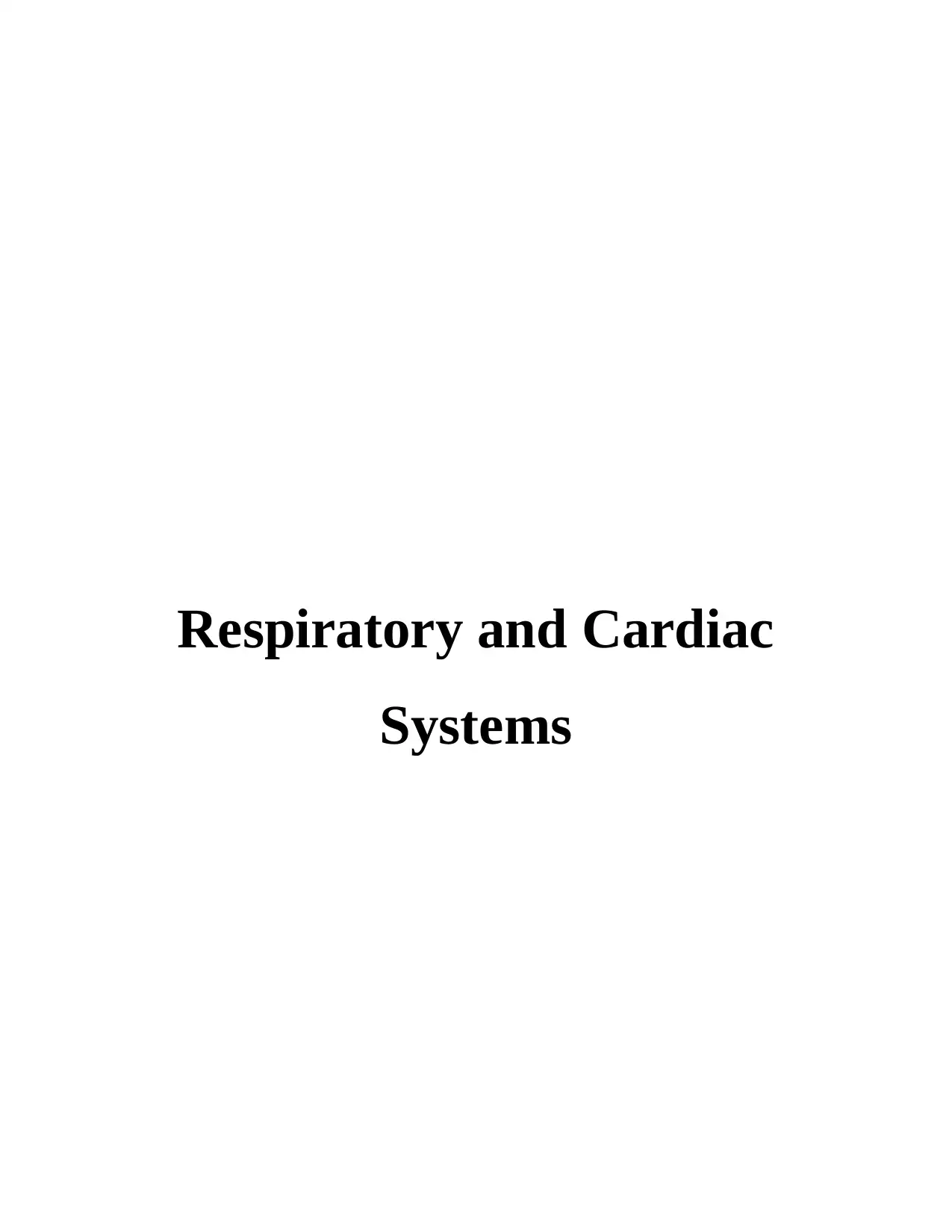
Respiratory and Cardiac
Systems
Systems
Paraphrase This Document
Need a fresh take? Get an instant paraphrase of this document with our AI Paraphraser
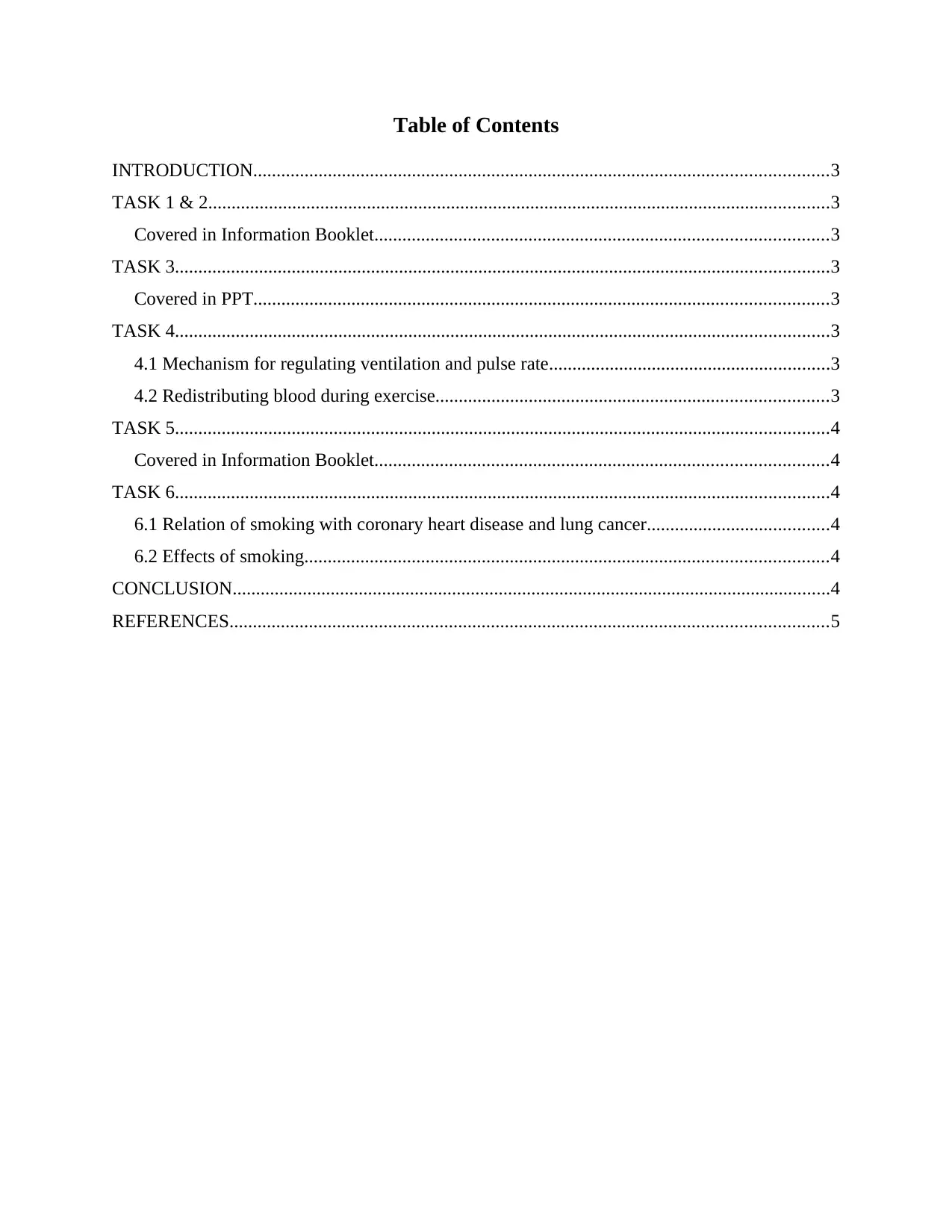
Table of Contents
INTRODUCTION...........................................................................................................................3
TASK 1 & 2.....................................................................................................................................3
Covered in Information Booklet.................................................................................................3
TASK 3............................................................................................................................................3
Covered in PPT...........................................................................................................................3
TASK 4............................................................................................................................................3
4.1 Mechanism for regulating ventilation and pulse rate............................................................3
4.2 Redistributing blood during exercise....................................................................................3
TASK 5............................................................................................................................................4
Covered in Information Booklet.................................................................................................4
TASK 6............................................................................................................................................4
6.1 Relation of smoking with coronary heart disease and lung cancer.......................................4
6.2 Effects of smoking................................................................................................................4
CONCLUSION................................................................................................................................4
REFERENCES................................................................................................................................5
INTRODUCTION...........................................................................................................................3
TASK 1 & 2.....................................................................................................................................3
Covered in Information Booklet.................................................................................................3
TASK 3............................................................................................................................................3
Covered in PPT...........................................................................................................................3
TASK 4............................................................................................................................................3
4.1 Mechanism for regulating ventilation and pulse rate............................................................3
4.2 Redistributing blood during exercise....................................................................................3
TASK 5............................................................................................................................................4
Covered in Information Booklet.................................................................................................4
TASK 6............................................................................................................................................4
6.1 Relation of smoking with coronary heart disease and lung cancer.......................................4
6.2 Effects of smoking................................................................................................................4
CONCLUSION................................................................................................................................4
REFERENCES................................................................................................................................5
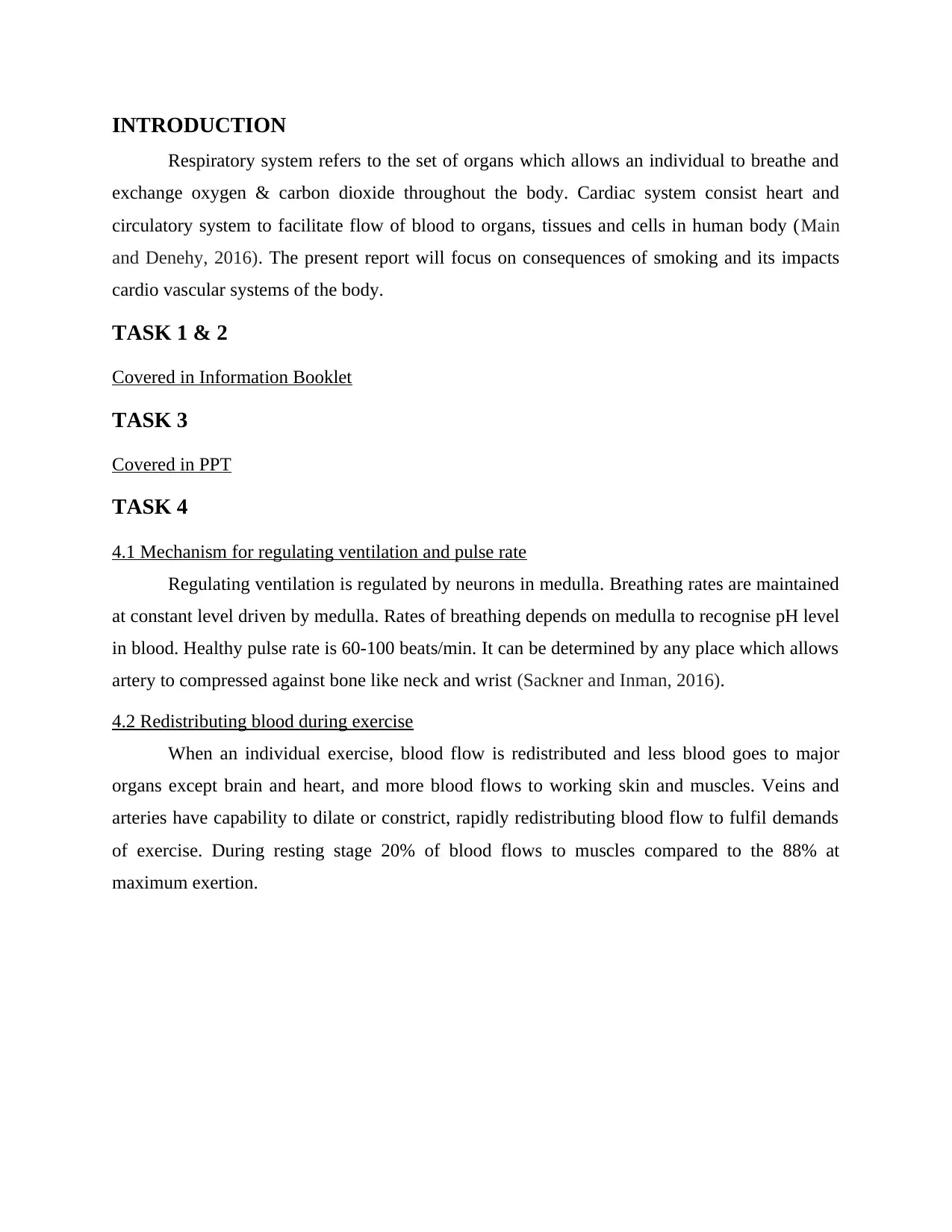
INTRODUCTION
Respiratory system refers to the set of organs which allows an individual to breathe and
exchange oxygen & carbon dioxide throughout the body. Cardiac system consist heart and
circulatory system to facilitate flow of blood to organs, tissues and cells in human body (Main
and Denehy, 2016). The present report will focus on consequences of smoking and its impacts
cardio vascular systems of the body.
TASK 1 & 2
Covered in Information Booklet
TASK 3
Covered in PPT
TASK 4
4.1 Mechanism for regulating ventilation and pulse rate
Regulating ventilation is regulated by neurons in medulla. Breathing rates are maintained
at constant level driven by medulla. Rates of breathing depends on medulla to recognise pH level
in blood. Healthy pulse rate is 60-100 beats/min. It can be determined by any place which allows
artery to compressed against bone like neck and wrist (Sackner and Inman, 2016).
4.2 Redistributing blood during exercise
When an individual exercise, blood flow is redistributed and less blood goes to major
organs except brain and heart, and more blood flows to working skin and muscles. Veins and
arteries have capability to dilate or constrict, rapidly redistributing blood flow to fulfil demands
of exercise. During resting stage 20% of blood flows to muscles compared to the 88% at
maximum exertion.
Respiratory system refers to the set of organs which allows an individual to breathe and
exchange oxygen & carbon dioxide throughout the body. Cardiac system consist heart and
circulatory system to facilitate flow of blood to organs, tissues and cells in human body (Main
and Denehy, 2016). The present report will focus on consequences of smoking and its impacts
cardio vascular systems of the body.
TASK 1 & 2
Covered in Information Booklet
TASK 3
Covered in PPT
TASK 4
4.1 Mechanism for regulating ventilation and pulse rate
Regulating ventilation is regulated by neurons in medulla. Breathing rates are maintained
at constant level driven by medulla. Rates of breathing depends on medulla to recognise pH level
in blood. Healthy pulse rate is 60-100 beats/min. It can be determined by any place which allows
artery to compressed against bone like neck and wrist (Sackner and Inman, 2016).
4.2 Redistributing blood during exercise
When an individual exercise, blood flow is redistributed and less blood goes to major
organs except brain and heart, and more blood flows to working skin and muscles. Veins and
arteries have capability to dilate or constrict, rapidly redistributing blood flow to fulfil demands
of exercise. During resting stage 20% of blood flows to muscles compared to the 88% at
maximum exertion.
⊘ This is a preview!⊘
Do you want full access?
Subscribe today to unlock all pages.

Trusted by 1+ million students worldwide
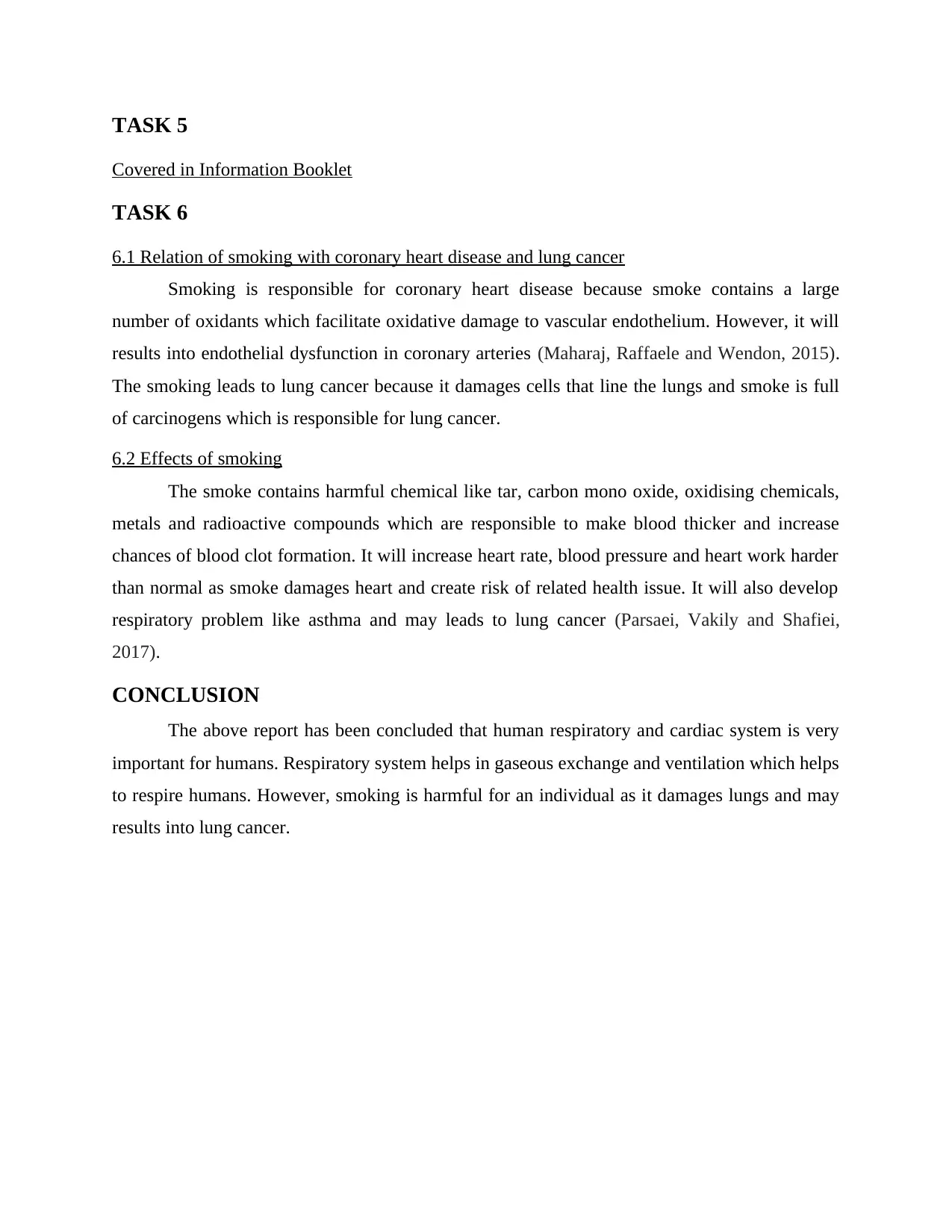
TASK 5
Covered in Information Booklet
TASK 6
6.1 Relation of smoking with coronary heart disease and lung cancer
Smoking is responsible for coronary heart disease because smoke contains a large
number of oxidants which facilitate oxidative damage to vascular endothelium. However, it will
results into endothelial dysfunction in coronary arteries (Maharaj, Raffaele and Wendon, 2015).
The smoking leads to lung cancer because it damages cells that line the lungs and smoke is full
of carcinogens which is responsible for lung cancer.
6.2 Effects of smoking
The smoke contains harmful chemical like tar, carbon mono oxide, oxidising chemicals,
metals and radioactive compounds which are responsible to make blood thicker and increase
chances of blood clot formation. It will increase heart rate, blood pressure and heart work harder
than normal as smoke damages heart and create risk of related health issue. It will also develop
respiratory problem like asthma and may leads to lung cancer (Parsaei, Vakily and Shafiei,
2017).
CONCLUSION
The above report has been concluded that human respiratory and cardiac system is very
important for humans. Respiratory system helps in gaseous exchange and ventilation which helps
to respire humans. However, smoking is harmful for an individual as it damages lungs and may
results into lung cancer.
Covered in Information Booklet
TASK 6
6.1 Relation of smoking with coronary heart disease and lung cancer
Smoking is responsible for coronary heart disease because smoke contains a large
number of oxidants which facilitate oxidative damage to vascular endothelium. However, it will
results into endothelial dysfunction in coronary arteries (Maharaj, Raffaele and Wendon, 2015).
The smoking leads to lung cancer because it damages cells that line the lungs and smoke is full
of carcinogens which is responsible for lung cancer.
6.2 Effects of smoking
The smoke contains harmful chemical like tar, carbon mono oxide, oxidising chemicals,
metals and radioactive compounds which are responsible to make blood thicker and increase
chances of blood clot formation. It will increase heart rate, blood pressure and heart work harder
than normal as smoke damages heart and create risk of related health issue. It will also develop
respiratory problem like asthma and may leads to lung cancer (Parsaei, Vakily and Shafiei,
2017).
CONCLUSION
The above report has been concluded that human respiratory and cardiac system is very
important for humans. Respiratory system helps in gaseous exchange and ventilation which helps
to respire humans. However, smoking is harmful for an individual as it damages lungs and may
results into lung cancer.
Paraphrase This Document
Need a fresh take? Get an instant paraphrase of this document with our AI Paraphraser
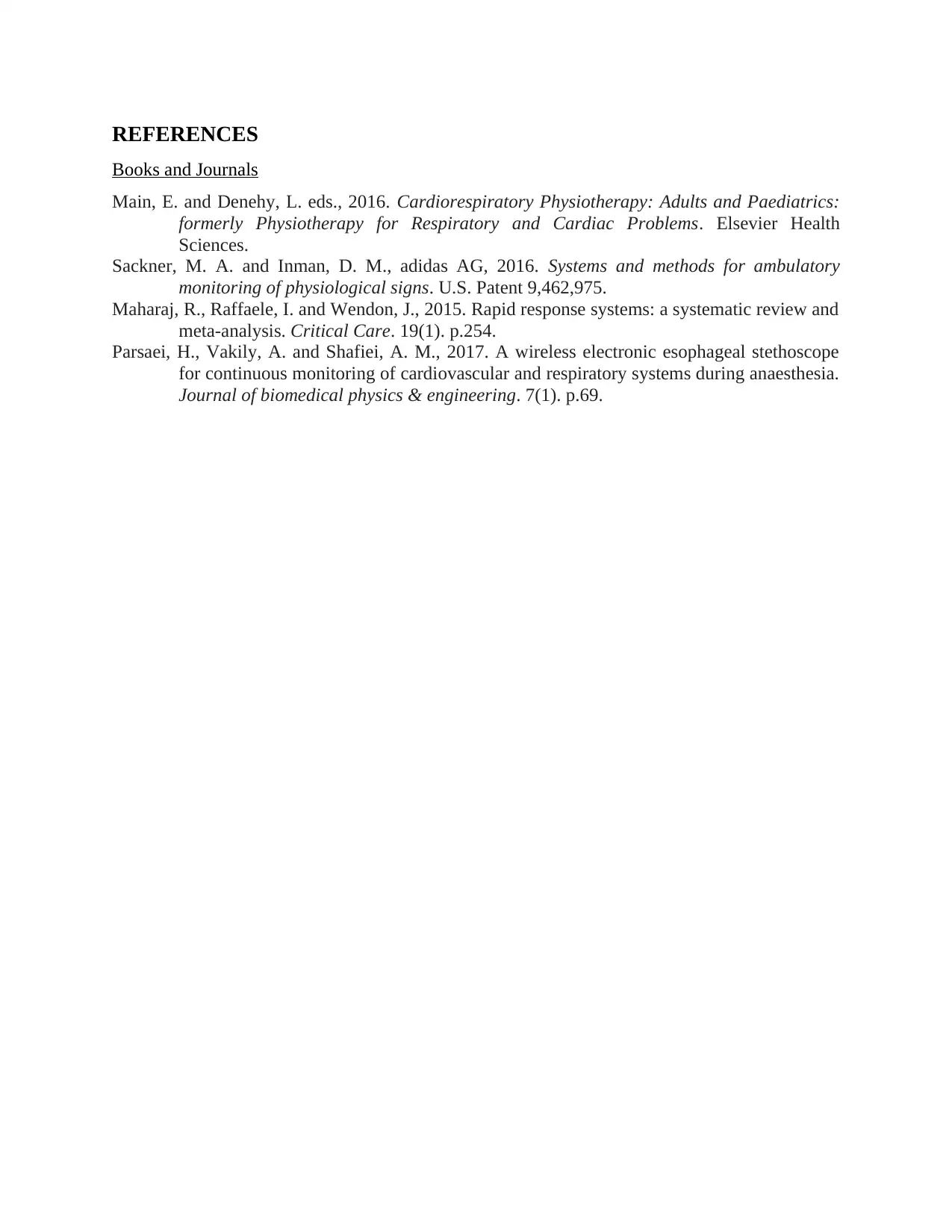
REFERENCES
Books and Journals
Main, E. and Denehy, L. eds., 2016. Cardiorespiratory Physiotherapy: Adults and Paediatrics:
formerly Physiotherapy for Respiratory and Cardiac Problems. Elsevier Health
Sciences.
Sackner, M. A. and Inman, D. M., adidas AG, 2016. Systems and methods for ambulatory
monitoring of physiological signs. U.S. Patent 9,462,975.
Maharaj, R., Raffaele, I. and Wendon, J., 2015. Rapid response systems: a systematic review and
meta-analysis. Critical Care. 19(1). p.254.
Parsaei, H., Vakily, A. and Shafiei, A. M., 2017. A wireless electronic esophageal stethoscope
for continuous monitoring of cardiovascular and respiratory systems during anaesthesia.
Journal of biomedical physics & engineering. 7(1). p.69.
Books and Journals
Main, E. and Denehy, L. eds., 2016. Cardiorespiratory Physiotherapy: Adults and Paediatrics:
formerly Physiotherapy for Respiratory and Cardiac Problems. Elsevier Health
Sciences.
Sackner, M. A. and Inman, D. M., adidas AG, 2016. Systems and methods for ambulatory
monitoring of physiological signs. U.S. Patent 9,462,975.
Maharaj, R., Raffaele, I. and Wendon, J., 2015. Rapid response systems: a systematic review and
meta-analysis. Critical Care. 19(1). p.254.
Parsaei, H., Vakily, A. and Shafiei, A. M., 2017. A wireless electronic esophageal stethoscope
for continuous monitoring of cardiovascular and respiratory systems during anaesthesia.
Journal of biomedical physics & engineering. 7(1). p.69.
1 out of 5
Related Documents
Your All-in-One AI-Powered Toolkit for Academic Success.
+13062052269
info@desklib.com
Available 24*7 on WhatsApp / Email
![[object Object]](/_next/static/media/star-bottom.7253800d.svg)
Unlock your academic potential
Copyright © 2020–2025 A2Z Services. All Rights Reserved. Developed and managed by ZUCOL.





